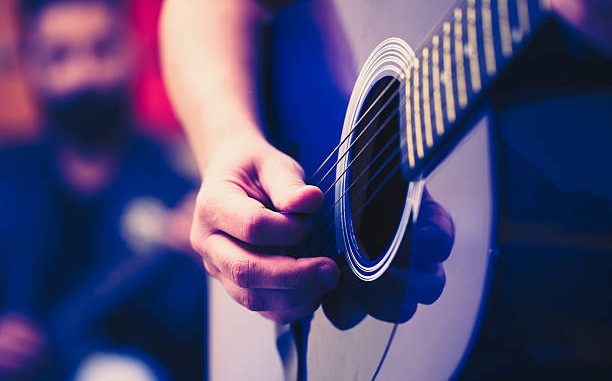
How to Play Guitar
Do you know that you have the possibility of getting the best music experience of your life? Giving education on how to play guitar, can be fun and even fulfilling exercise. Whether you are planning on playing some chords at a campfire or if you envision yourself as the rock star of the future, this guide will get your journey as a guitarist underway. Alright guys, well, come to the era of six strings, and let’s explore how to play guitar!

The guitar is one of the most well-liked string musical instruments that seems to have appreciation from both music players and fans globally. Being able to vary the size and the tonal properties of its resolution, the guitar involved almost all styles, beginning with classics and ending with rock and country, and moving to jazz. As much as playing guitars makes people develop voluminous possibilities, it can be a very fulfilling hobby or can offer a person the opportunity of being employed.
To start with, this article is a comprehensive one-stop guide to learning the guitar within the shortest time possible. In this tutorial, we will discuss where things are on the guitar, how to tune the guitar, what some of the basic chords appear to be like, and a few practice tips. At the start of this article, you did not even have an inkling of how to go about it, and at this point and time, you are well on your way to playing the guitar.
Getting Started: Choosing Your First Guitar
But ah! If you’re preparing yourself to learn how to play guitar, then what you want is an instrument. That’s why for newcomers it is better to start with an acoustic instrument since a classical guitar is more difficult to play. They are mobile instruments; they can easily be moved from one place to another, are cheaper compared to other instruments of music, and do not require electricity. However, if you have a leaning towards electric guitars, don’t be discouraged—get the one that looks most attractive.
When selecting your first guitar, consider factors such as:
- Size and comfort
- Budget
- Build quality
- Brand reputation
Just remind them that a first instrument doesn’t have to be expensive. Most inexpensive guitars are distortion pedals fine for starters studying how to play guitar.
Understanding Guitar Anatomy
It would therefore be relevant to know parts of the instrument to learn/play how to play guitar. Here’s a quick overview:
- Headstock: That can be easily where the tuning pegs are found.
- Neck: If you look at a guitar, it is reformed into a long, slim profile that stretches into the forehead.
- Fretboard: Where forcible empathy is applied to cause several details.
- Body: The main part of the guitar
- Bridge: Where the strings are fastened with hooks to the body
- Sound hole (on acoustic guitars): Amplifies the sound
- Pickups (on electric guitars): It traps and transform string vibrations into electrical signals.
Identifying these parts is essential for enhancing your ability to read other people’s work and for comprehending instructions as you learn how to play guitar.
Tuning Your Guitar
- Organize the broadcast channel selection with a digital tuner or a tuning application.
- Tune by ear by tuning the component or device that is being tuned on the base reference pitch.
- If none of these methods will work, use the 5th fret method, where you compare strings next to each other.
When you advance in learning how to play guitar, you can hear whether or not it is tuned right, and if not, you can correct it.
Tutorials: lessons for beginners or novices who are yet to learn how to play guitar Weights:
It is again categorized into lesson type that targets beginners or novices who hail in the music industry.
- A major
- D major
- G major
- C major
- E minor
- A minor
Learn optimal ways of changing from one or the other chord effortlessly. Once the fingers get comfortable with the strings, you can proceed to build your chord repertoire and add more forms.
Strumming patterns and rhythm
Picking is a primary technique in learning how to play guitar. It’s what puts rhythm and groove into your playing. Simply tap the basic rhythmic downbeats first and add upbeats to increase the complexity of the rhythm later.
Some basic strumming patterns to practice:
- Down, down, down,
- Down, down, down, down
- Down-up, and they call ‘down-up’ or something like that.
Make sure that your wrist is loose, and try to move from your forearm when you go for the strumming.
Fingerpicking Techniques
While strumming is fine for supporting vocalists or playing percussion, there is so much more you can do with your fingers. To start fingerpicking:
- Decide which of the fingers goes on which string; normally thumb for bass strings and the first, second, and third treble strings, respectively.
- Practice simple patterns; pick a single string at a time.
- Gradually, as the practice progresses, composite the motion of various fingers.
Fingerpicking is something that one should work on as he/she plays how to play guitar, more so if the learner has an aim of playing classical, folk, or fingerstyle guitar.
Reading Guitar Tablature
Tablature, abbreviated as tab, is a model of notation that I use for guitar music. It employs numbers on six lines denoting the strings to indicate where to place your fingers on the fretboard. It is extremely useful to learn how to read tabs, as this opens up options for learning new songs as you work out how to play guitar.
Introduction to Good Practice Habits
It is also important to ensure that with practice, it becomes consistent if you want to develop the skills of playing the guitar. Here are some tips for effective practice:
- It is recommendable to set aside time for practice in the same way that a person sets aside time for breakfast each day; it could take only 15- 30 minutes.
- Engage the difficulties and preferable techniques.
- Keep a metronome on while practicing playing to enhance your ability to keep time.
- Record yourself playing to track the progress.
- Learn songs you enjoy to keep you motivated.
Do not forget that learning how to play guitar is a process. You must give yourself some credit for achieving small tasks you accomplish during learning and growing your skills.
Expanding Your Guitar Skills
As you become more comfortable with the basics of how to play guitar, you can explore more advanced techniques:
- Barre chords
- Hammerons and pull-offs
- Slides and bends
- Palm muting
- Tapping
These techniques will help you develop more colors and interests for the role that you play in a musical instrument.
Playing with Others
When you are a bit more confident with sharing on guitar, it is advisable to share with other musicians. This could include participating in a live band, going to further jamming, or just merry making with fellow friends or musicians. That means that by practicing with others, you will develop good timing and listening skills, among other musical skills.

Conclusion
Learning is one of the most fascinating and pleasant processes of human life. This is the complete opposite of what most people reason: if you invest the time and effort and practice diligently, you will be astonished at the pace of your advancement from a rank novice to a sensibly able player. Please do not forget that it is fun to play, so have fun, be proud of your achievements, and never leave low-string unmanned.
FAQs
What dictation does it take to learn how to play guitar?
Distance learning is quite personal and is determined by the period required to learn guitar. After one or two months of regular practice chords for the beginning as well as the simplest of the songs can be mastered. It can take several years to become proficient in a language, but never mind, it will be fun!
How important and relevant is it for me to learn the various theories while playing the guitar?
It may not be essential to learn music theory to play the guitar, but this knowledge will help. I think chord progression, scales, and even the structure of the songs are some of the areas that it assists with. However, most guitar players learn to play without having to use theory and acquire it in between their practice.
Click this link to access the GuitarTricks.com Free Trial page >>
Click here to access the GuitarTricks.com Free Trial >>
Leave a Reply